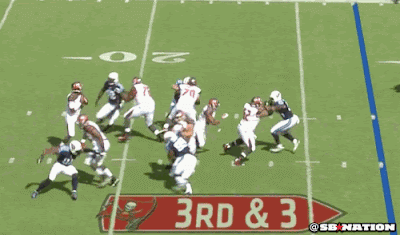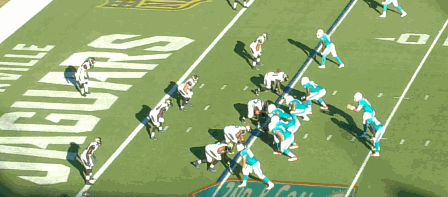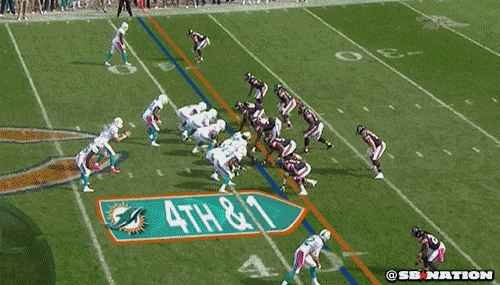(Written on 11/5/15)
Now that the NFL is at the half-way point, let’s take a look at the league’s top performers thus far.
Offense-Quarterback: Tom Brady (New England Patriots)
Brady is having a career year, one that rivals that of his 2007 season, ranking first in touchdowns (20), rating (115.8), and yards per game (344), second in yards (2,410), sixth in completion percentage (68.9) all while throwing only one interception, a mind-boggling statistic; he has also completed more than 74 percent of his passes three times and thrown for more than 3 TDs four times this season. In three games against AFC East opponents, Brady has completed 64.9 percent of his passes for 1,177 yards and nine touchdowns, without throwing an interception, for an astounding average of 392 yards and three touchdowns per game. Brady is the head of an offense that is sixth in total offense and second in points, all while maintaining their 7-0 record.
Running back: Devonta Freeman (Atlanta Falcons)
Freeman has come from possibly being replaced by second rounder Tevin Coleman this past May to potential MVP. His 709 rushing yards and whopping nine touchdowns ranks first in the league, while carrying the ball a league high 152 times; his 4.7 yards per carry is third among all running backs with 100+ carries. Despite leading the league in carries, Freeman has only fumbled once this season while also ranking first with 45 runs that have gone for first downs, nine more than the next back. Freeman also has Pro Football Focus‘ third highest overall grade and sixth highest run grade despite the fact he leads the league run snaps by 18. He has also had a major impact in the passing game having caught 40 passes for 353 yards and a touchdown, first and second among all running backs respectively; he has the sixth highest receiving grade among all running backs according to PFF.
Doug Martin (Tampa Bay Buccaneers)
Just a few months ago it’s hard to imagine anyone, truthfully, considering Martin an All-Pro after two disastrous, injury-riddled seasons following his stellar 2012 season that saw him rush for 1,454 yards and 11 touchdowns on 319 carries (4.6 avg.) while hauling in 49 passes for 472 yards and a touchdown in all 16 games. Between 2013-2014, Martin played in 17 total games and rushed for 950 yards and three touchdowns on 261 carries (3.6 avg.)doug martin while catching 25 passes for 44 yards, thus playing as a shell of his former self. Martin has resurrected his career as his 132 carries for 612 yards rank sixth and fourth respectively in the NFL. His 4.6 average yards per carry ranks fifth among all running backs with 100+ carries; he ranks second in 20+ yard runs with seven and 11th with 24 rushes that have gone for first downs. PFF has also showcased his impact as his 92.3 overall grade and 89.8 run grade ranks second among all running backs in both categories, all while being on the field for the seventh most run snaps in the league. Martin has also been phenomenal in the passing game with 15 catches for 136 yards and a touchdown and the fourth highest pass block grade among all running backs. Martin has done it all behind a porous offensive line featuring two centers that have received poor and average grades, a guard who has received an average grade, and three tackles that have received two poor grades and an average grade all via PFF.
Fullback: Patrick DiMarco (Atlanta Falcons)
Fullbacks have become something of a dying breed but DiMarco’s impact cannot be overlooked. While he has been the lead blocker for the NFL’s top rusher, DiMarco’s 88.3 overall PFF grade is tops among all fullbacks and is 8.2 points higher than the next. Freeman owes a majority of his success to DiMarco as he has posted a remarkable 91.8 run blocking grade in 116 run snaps, second in the league by one snap. The most impressive aspect? He is a whopping 13.4 points higher than the NEXT fullback; he is also tied for seventh in the running game and has the fourth highest receiving grade.
Wide Receiver: Julio Jones (Atlanta Falcons)
Jones has been nothing short of unstoppable this year. After a stellar 2014 campaign that saw him catch 104 passes for 1,593 yards and six touchdowns, Jones has reeled in 70 passes for 892 yards through eight games, tops in the NFL; he has already matched last season’s touchdown total, good for t-second in the NFL. Jones has been targeted 103 times, second in the NFL, catching 68% of all targets. Jones has also used his explosiveness to put up numbers, ranking fourth in the NFL with 12 catches of 20+ yards, sixth in yards after the catch with 277, and second in receptions that have gone for first downs with 45. PFF has given him the highest overall grade and receiving grade among all receivers while being on the field for the seventh most pass snaps.
DeAndre Hopkins (Houston Texans)
Jones and Hopkins have been 1a and 1b all season long as Hopkins ranks third behind Jones in receptions (66) and yards (870). Hopkins is also t-second in touchdowns with six, t-fifth with 10 catches for 20+ yards, and first with 54 receptions that have gone for first downs. His 92.2 overall grade via PFF ranks fourth among all receivers while his 91.1 receiving grade ranks third while being on the field for a whopping 401 pass snaps, 35 more than the next. While Hopkins has been MVP caliber, he has done so with unbelievably inconsistent and often-times, below average quarterback play, making his numbers that much more impressive.
Tight End: Rob Gronkowski (New England Patriots)
When healthy, Gronk is undoubtedly the best tight end in the game and he has proven that thus far. Although he ranks 12th in the NFL in receptions and yards, he is first among all tight ends and is t-first among all players with seven touchdowns. His 273 yards after the catch are seventh in the league and ranks only behind Travis Kelce among all tight ends; he comes in at second in receptions of 20+ yards and ninth in receptions that have gone for first downs, tied with Cleveland’s Gary Barnidge among all tight ends. Not surprisingly, Gronk’s 97.4 overall grade Pats, Gronk strike quickly-media-1ranks first among all tight ends PFF has graded, 7.1 points more than the next tight end; his 97.9 receiving grade is also first among all tight ends. While Barnidge likely deserves this spot due to his numbers that resemble Gronk’s with nowhere near the same quarterback play, Gronk gets the nod due to his blocking ability. He’s been on the field for 320 pass snaps, third most among all tight ends via PFF, with an 87.6 pass blocking grade, also third among all tight ends. He has been a factor in the run game as well, ranking first among all tight ends with an 82.4 run blocking grade.
Tackle: Tyron Smith (Dallas Cowboys)
Smith has been an elite left tackle for the last two years and the anchor of a dominant Cowboys offensive line that ranks 10th in the NFL in rushing yards despite five different running backs carrying the ball at least five times. In seven games, Smith has only been called for four penalties; only one was a holding call. He has also allowed an exceptionally low three sacks which would leave one to believe how many are truly his fault with Brandon Weeden and Matt Cassel playing quarterback. His 94.8 overall PFF grade ranks first among all offensive tackles and is second behind Joe Thomas in pass blocking by a lowly .5 points. He has posted an astonishing 99.4 run blocking grade as well as Dallas is 10th best when running off the left tackle according to Pro Football Outsiders.
Joe Thomas (Cleveland Browns)
Thomas is arguably the best left tackle since 2007 and he shows no signs of slowing down. He is second behind Smith in PFF’s overall grade, but leads all tackles with a 93.7 pass blocking grade and is third in run blocking while being on the field for the fifth most pass snaps and 11th most run snaps respectively. He has committed a minuscule five penalties, only one of which was a holding. Thomas has only surrendered a mind-blowing half sack which, if he maintained that average, would be one sack allowed all season, two fewer than his all time low. Thomas’ durability is also impressive as he has started 136 straight games.
Guards: Marshal Yanda (Baltimore Ravens)
Yanda has long been a staple of the Ravens’ success up front and it is no different this year. He is PFF’s top guard with a 93.8 overall grade and has yet to commit a single penalty while only allowing half a sack. He has been on the field for 364 pass snaps, fourth in the league, recording the seventh pass blocking grade. In the run game, his 214 run snaps are sixth most among all guards while recording a league high 94.6 run grade. The Ravens rank fifth when running between their guards according to PFO.
Zack Martin (Dallas Cowboys)
The Cowboys offensive line is still intact with Martin anchoring the interior. Although he has allowed the same amount of sacks committed the same amount of penalties through seven games as he did all of last season, it’s easy to attribute that to the three different quarterbacks that have started for Dallas this season. Nevertheless, Martin is PFF’s second highest rated guard with the highest pass blocking grade in the league while holding the league’s third highest run blocking grade.
Center: Ryan Kalil (Carolina Panthers)
The man in the middle of Carolina’s offensive line has been stellar this year. He is PFF’s highest rated center with the highest run blocking grade, each ahead of the next guy by at least 4 points. His impact in the passing game has been felt too as he ranks seventh in pass protection. Although he missed Monday night’s game against the Colts, Kalil has started six games this year and committed only one penalty and allowed only a single sack.
Defense-Defensive End: J.J. Watt (Houston Texans)
The Watt narrative has yet to show any signs at all of slowing down. Watt’s 8.5 sacks are tied for a league high while his 40 tackles are second amongst all defensive ends. The kicker? Watt is a 3-4 end who is facing more double teams than ever before; he is also tied for ninth in the league in passes defended. While he is technically a defensive end, he would be an interior defender in a true 4-3 and is thus, listed as an interior defender by PFF which has granted him the highest grade among all interior defenders. He has been on the field for a league high 317 pass snaps, and of course possesses PFF’s highest pass rush grade; Watt has also been on the field for a league high 221 run snaps while maintaining the league’s fourth highest grade against the run.
Cameron Jordan (New Orleans Saints)
A bit of a surprise this season, Jordan’s six sacks are fourth in the NFL; he has also defended four passes and forced a fumble along the way. Jordan is PFF’s top edge defender with a 94.8 overall grade coupled with his top pass rush grade while being on the field for the more pass snaps than any other edge defender. He has been stout against the run as well, ranking sixth in run defense while t-fifth for most run snaps.
Defensive Tackle: Kawann Short (Carolina Panthers)
PFT Live: Kawann Short, Eagles talk with Geoff Mosher-media-1Short has been an anchor and a force for the Panthers this season, ranking second in sacks by defensive tackles with five (t-sixth in the NFL). His play making ability has been on display this year with his 27 tackles, four passes defended, and a forced fumble. Short is PFF’s third highest rated interior defender with the fifth highest rated pass rush grade while being on the field for the 11th most pass snaps; his impact against the run has been felt too, ranking 10th in run defense.
Muhammad Wilkerson (New York Jets)
Wilkerson has been a force along the Jets’ line this year, registering five sacks (t-sixth in the NFL), racking up 31 tackles, a forced fumble, and defending four passes. He is PFF’s seventh rated interior defender, has been stout against the run (eighth in the league), and thirteenth in pass rush while being on the field for the third most pass snaps.
Linebackers: Thomas Davis (Carolina Panthers)
While fellow linebacker Luke Kuechly is more valuable to the Panthers via PFF and talent wise, it’s hard to ignore his teammates’ numbers. Davis is 12th in the league with 59 total tackles. He’s been all over the field, registering two sacks, two interceptions, and a forced fumble while defending three passes. His impact in coverage has also been felt as he ranks third among all linebackers in that category via PFF.
Luke Kuechly (Carolina Panthers)
Kuechly has only played in four games this season due to injury but he has made a stellar 46 stops, a per-game average that would give him 184 tackles in 16 games; Kuechly has also recorded an interception and a sack. Furthermore, he has an astounding 99 overall grade by PFF, leading all linebackers while his 94.7 grade against the run and 95.7 grade in coverage are also tops among all linebackers.
Telvin Smith (Jacksonville Jaguars)
Telvin Smith’s pick six nets AFC defensive player of week honors-media-1Despite their struggles, the Jaguars have play makers on both sides of the ball and Smith has been one all season. His 68 tackles rank fifth in the NFL while his play making ability is highlighted by his impressive stat line: a half sack, four passes defended, an interception that went 26 yards for a touchdown, and seven stuffs (when an offensive team attempts a run up the middle that gets completely denied by the defense at or behind the line of scrimmage) for 19 yards.
Cornerbacks: Josh Norman (Carolina Panthers)
Another star of this dominant Panthers defense is Norman who is having a fantastic season. He is tied for second in passes defended (12) and interceptions (four) and leads the league in defensive touchdowns with two; Norman has also forced and recovered a fumble and has done a brilliant job of keeping everything in front of him with only 28 tackles. He is also PFF’s top corner with a 96.1 overall grade and 95.6 cover grade, allowing just 45.9 percent of 37 passes thrown his way to be caught while quarterbacks have a 24.1 passer rating when throwing his way.
Dominique Rodgers-Cromartie (New York Giants)
In his eighth season, Rodgers-Cromartie is having a career year in New York. He is t-third in the NFL in interceptions, one of which went for a touchdown, and t-eighth in passes defended while forcing two fumbles and returning one for a touchdown. He is PFF’s sixth overall rated corner, seventh in coverage, and eighth against the run.
Safeties: Charles Woodson (Oakland Raiders)
The Michigan product will surely be a first ballot Hall of Famer when he walks away, but the 39-year-old seems to be saving his best for last. He leads the league in interceptions with five, two of which came against fellow legend Peyton Manning. He has defended the seventh most passes and recorded 33 tackles; Woodson is PFF’s highest rated safety in coverage while being on the field for the fourth most pass snaps.
Reshad Jones (Miami Dolphins)
This rising star has shown improvement since 2013, and has returned both of his interceptions this season for touchdowns. Jones has had countless opportunities to make tackles due to the Dolphins porous run defense (t-21st), making the most of it with a whopping 67 tackles this season all without missing a single one according to PFF. He is also their third highest graded safety this season, 10th in pass coverage (he has only been targeted 10 times this season), and first against the run.
*Minnesota Vikings’ Harrison Smith was a close second
Special Teams-Kicker: Stephen Gostkowski (New England Patriots)
Gostkowski has been absolute nails this season going 17-17 on field kicks including an amazing 6-6 from 40-49 yards out and 3-3 from 50+ including a 57 yarder this season, second longest this season. Even more incredible, Gostkowski is 28-28 on extra points this season, the second most made and attempted this season.
Punter: Johnny Hekker (St. Louis Rams)
His 48.8 yards per punt is sixth in the NFL despite only punting the ball 39 times while his net punting average of 43.7 ranks third. Hekker has yet to have a punt blocked and has dropped 16 punts inside the 20 (second in the league); only two punts have been touch backs (t-third fewest in the league) and he has forced 10 fair catches, t-fifth most in the league.
Returner: Tyler Lockett (Seattle Seahawks)
The Seahawks got exactly what they were looking for in Lockett, a return man who can shift the field. His 356 kick return yards are the sixth most in the NFL while his 105 yard return, which went for a touchdown, is the second longest this season; his 25.4 yard per return is seventh most amongst those with double-digit returns. He has also returned 24 punts for 195 yards, ninth in the NFL, and one for a touchdown.







/cdn0.vox-cdn.com/uploads/chorus_asset/file/676054/carr-3.0.gif)





